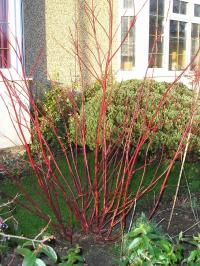Canine Qualities: Dogwoods in Winter
 Although not colourfull in foliage, the bark of Winter Dogwoods can be quite striking
Although not colourfull in foliage, the bark of Winter Dogwoods can be quite strikingThe attributes of the Dogwoods and their importance in the winter garden.
Apparently, the dog is supposed to be man's best friend. In mid Winter, the dogwoods (Cornus species) are amongst many gardeners best friends.
It is in mid Winter that the dogwoods really come into their own in the garden. It is the strikingly colourful young stems (pictured) of these shrubs that act as a ray of light, drawing the eye like a scout to a camp fire, whatever the weather may hold on a winter's day.
The family Cornaceae is a large one, made up of many small shrubs and trees. In the wild, they are mainly found growing in temperate areas of the Northern Hemisphere. It is the cultivars of Cornus alba, C. sanguinea and C. stolonifera that we mainly associate and classify as the winter dogwoods with their attractive, colourful bark.
Cornus alba cultivars all have bright red winter stems, the cultivars differ in other ways. 'Aurea' for example has golden yellow foliage, C.alba 'Gouchaultii' has pink tinged, yellow margined leaves. C.alba 'Kesselringii' has purple-black young wood complemented by foliage that turns purple in autumn.
Cultivars of Cornus sanguinea also provide excellent winter colour stem effect e.g. 'Midwinter Fire' as the name suggests has fiery stems of orange and red.
Cornus stolonifera cultivars are particularly useful on damp and boggy soil, for example on the edge of a pond, their roots tolerate very wet soil. C.stolifera 'Flaviramea' has bright yellow-green young shoots and provides an excellent contrast when planted next to one of the red stemmed dogwoods.
If space is limited in the garden, C.stolonifera 'Kelseyi' will only grow to a height and spread of 80 cm and 1.6 m respectively.
The intensity of the bark colour on the winter dogwoods is always most intense on the youngest wood. It is therefore necessary to hard prune the plants every spring, this generates the new wood and the stunning colours. The pruning technique is best described as pollarding. When the time is right, I will write an article about the pruning of winter dogwoods.
The flowers of the winter dogwoods are usually produced in late spring and early summer. They are usually white or creamy-white and borne on a flat-topped umbrella like flower structure called a cyme.
Fruits are usually small, spherical and white in colour, sometimes tinged blue.
If you want to increase your stock of winter dogwoods they root quite easily from pencil thick hardwood cuttings taken in autumn.
Carefully located, winter dogwoods can be viewed from the comfort of your fireside armchair with a winter's sunset in the background; Enjoy!
Filed under Shrubs.
